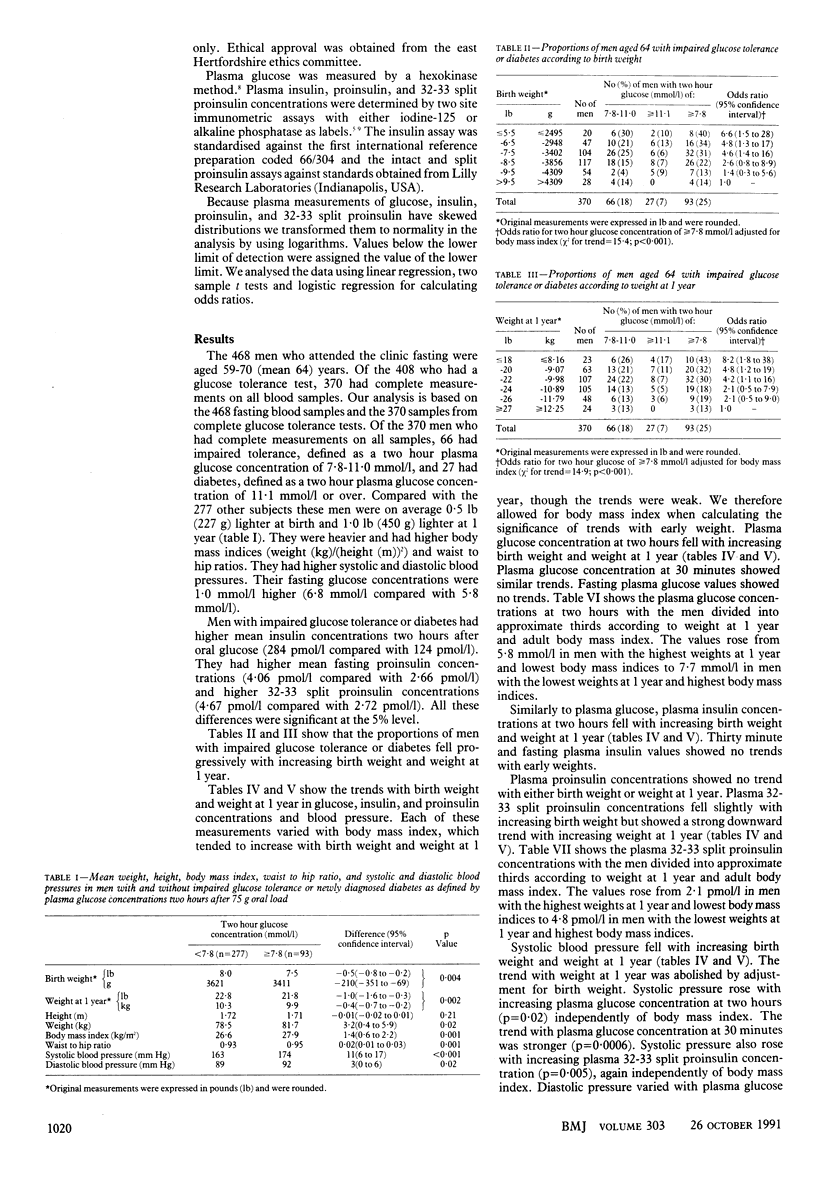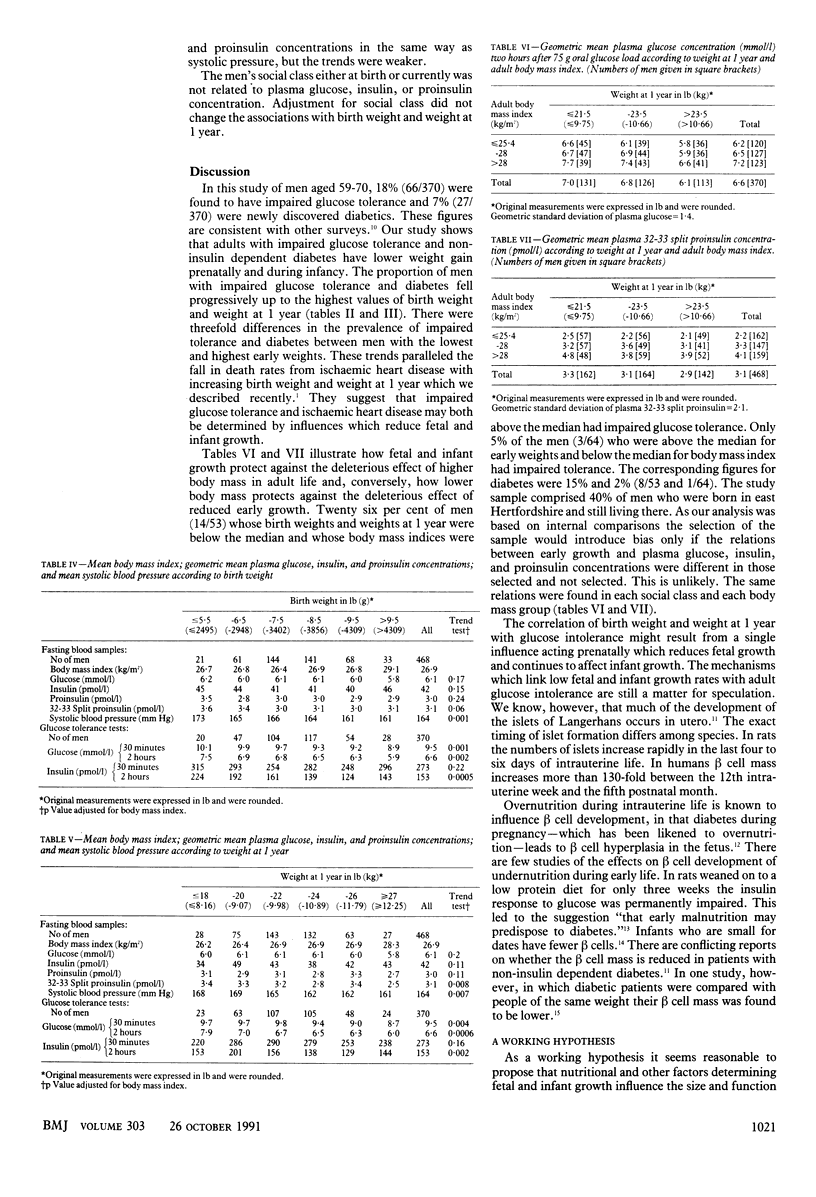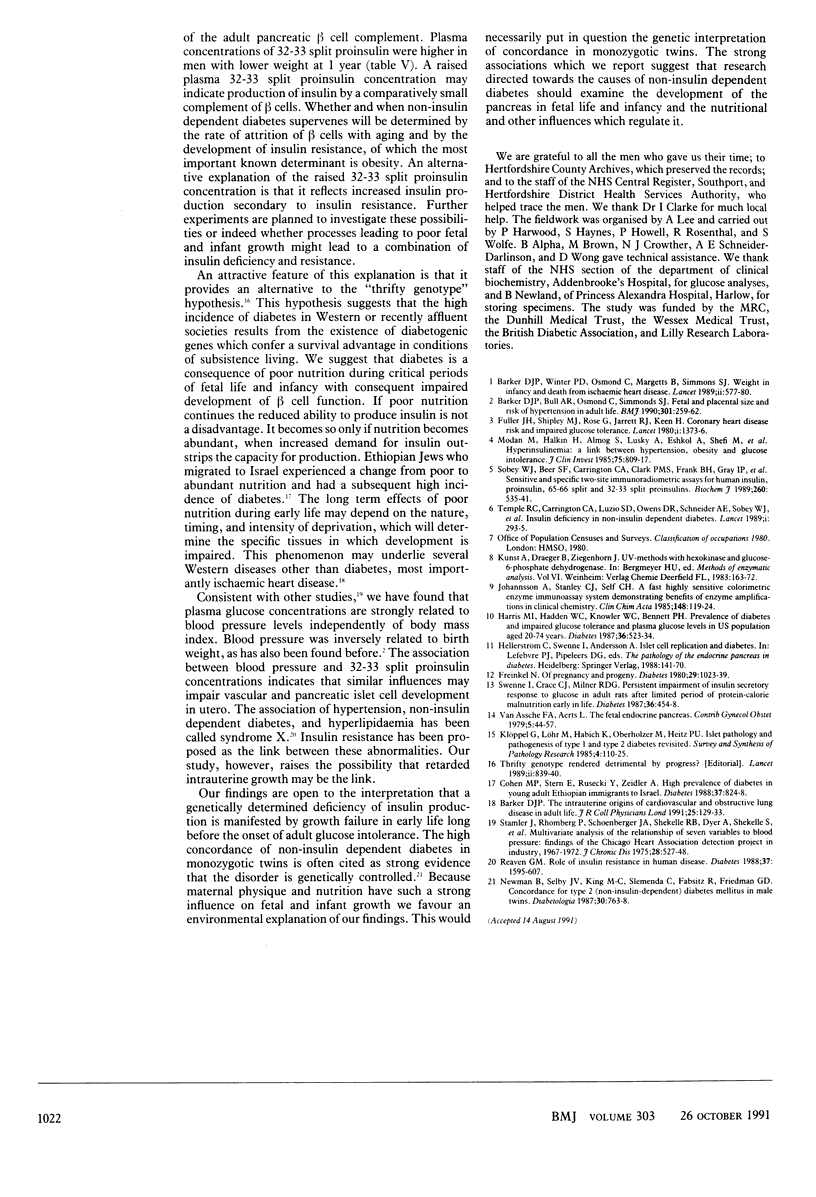Abstract
OBJECTIVE--To discover whether reduced fetal and infant growth is associated with non-insulin dependent diabetes and impaired glucose tolerance in adult life. DESIGN--Follow up study of men born during 1920-30 whose birth weights and weights at 1 year were known. SETTING--Hertfordshire, England. SUBJECTS--468 men born in east Hertfordshire and still living there. MAIN OUTCOME MEASURES--Fasting plasma glucose, insulin, proinsulin, and 32-33 split pro-insulin concentrations and plasma glucose and insulin concentrations 30 and 120 minutes after a 75 g glucose drink. RESULTS--93 men had impaired glucose tolerance or hitherto undiagnosed diabetes. They had had a lower mean birth weight and a lower weight at 1 year. The proportion of men with impaired glucose tolerance fell progressively from 26% (6/23) among those who had weighted 18 lb (8.16 kg) or less at 1 year to 13% (3/24) among those who had weighed 27 lb (12.25 kg) or more. Corresponding figures for diabetes were 17% (4/23) and nil (0/24). Plasma glucose concentrations at 30 and 120 minutes fell with increasing birth weight and weight at 1 year. Plasma 32-33 split proinsulin concentration fell with increasing weight at 1 year. All these trends were significant and independent of current body mass. Blood pressure was inversely related to birth weight and strongly related to plasma glucose and 32-33 split proinsulin concentrations. CONCLUSIONS--Reduced growth in early life is strongly linked with impaired glucose tolerance and non-insulin dependent diabetes. Reduced early growth is also related to a raised plasma concentration of 32-33 split proinsulin, which is interpreted as a sign of beta cell dysfunction. Reduced intrauterine growth is linked with high blood pressure, which may explain the association between hypertension and impaired glucose tolerance.
Full text
PDF



Selected References
These references are in PubMed. This may not be the complete list of references from this article.
- Barker D. J., Bull A. R., Osmond C., Simmonds S. J. Fetal and placental size and risk of hypertension in adult life. BMJ. 1990 Aug 4;301(6746):259–262. doi: 10.1136/bmj.301.6746.259. [DOI] [PMC free article] [PubMed] [Google Scholar]
- Barker D. J. The intrauterine origins of cardiovascular and obstructive lung disease in adult life. The Marc Daniels Lecture 1990. J R Coll Physicians Lond. 1991 Apr;25(2):129–133. [PMC free article] [PubMed] [Google Scholar]
- Barker D. J., Winter P. D., Osmond C., Margetts B., Simmonds S. J. Weight in infancy and death from ischaemic heart disease. Lancet. 1989 Sep 9;2(8663):577–580. doi: 10.1016/s0140-6736(89)90710-1. [DOI] [PubMed] [Google Scholar]
- Cohen M. P., Stern E., Rusecki Y., Zeidler A. High prevalence of diabetes in young adult Ethiopian immigrants to Israel. Diabetes. 1988 Jun;37(6):824–828. doi: 10.2337/diab.37.6.824. [DOI] [PubMed] [Google Scholar]
- Freinkel N. Banting Lecture 1980. Of pregnancy and progeny. Diabetes. 1980 Dec;29(12):1023–1035. doi: 10.2337/diab.29.12.1023. [DOI] [PubMed] [Google Scholar]
- Fuller J. H., Shipley M. J., Rose G., Jarrett R. J., Keen H. Coronary-heart-disease risk and impaired glucose tolerance. The Whitehall study. Lancet. 1980 Jun 28;1(8183):1373–1376. doi: 10.1016/s0140-6736(80)92651-3. [DOI] [PubMed] [Google Scholar]
- Harris M. I., Hadden W. C., Knowler W. C., Bennett P. H. Prevalence of diabetes and impaired glucose tolerance and plasma glucose levels in U.S. population aged 20-74 yr. Diabetes. 1987 Apr;36(4):523–534. doi: 10.2337/diab.36.4.523. [DOI] [PubMed] [Google Scholar]
- Johannsson A., Stanley C. J., Self C. H. A fast highly sensitive colorimetric enzyme immunoassay system demonstrating benefits of enzyme amplification in clinical chemistry. Clin Chim Acta. 1985 May 30;148(2):119–124. doi: 10.1016/0009-8981(85)90221-9. [DOI] [PubMed] [Google Scholar]
- Klöppel G., Löhr M., Habich K., Oberholzer M., Heitz P. U. Islet pathology and the pathogenesis of type 1 and type 2 diabetes mellitus revisited. Surv Synth Pathol Res. 1985;4(2):110–125. doi: 10.1159/000156969. [DOI] [PubMed] [Google Scholar]
- Modan M., Halkin H., Almog S., Lusky A., Eshkol A., Shefi M., Shitrit A., Fuchs Z. Hyperinsulinemia. A link between hypertension obesity and glucose intolerance. J Clin Invest. 1985 Mar;75(3):809–817. doi: 10.1172/JCI111776. [DOI] [PMC free article] [PubMed] [Google Scholar]
- Newman B., Selby J. V., King M. C., Slemenda C., Fabsitz R., Friedman G. D. Concordance for type 2 (non-insulin-dependent) diabetes mellitus in male twins. Diabetologia. 1987 Oct;30(10):763–768. doi: 10.1007/BF00275741. [DOI] [PubMed] [Google Scholar]
- Reaven G. M. Banting lecture 1988. Role of insulin resistance in human disease. Diabetes. 1988 Dec;37(12):1595–1607. doi: 10.2337/diab.37.12.1595. [DOI] [PubMed] [Google Scholar]
- Sobey W. J., Beer S. F., Carrington C. A., Clark P. M., Frank B. H., Gray I. P., Luzio S. D., Owens D. R., Schneider A. E., Siddle K. Sensitive and specific two-site immunoradiometric assays for human insulin, proinsulin, 65-66 split and 32-33 split proinsulins. Biochem J. 1989 Jun 1;260(2):535–541. doi: 10.1042/bj2600535. [DOI] [PMC free article] [PubMed] [Google Scholar]
- Stamler J., Rhomberg P., Schoenberger J. A., Shekelle R. B., Dyer A., Shekelle S., Stamler R., Wannamaker J. Multivariate analysis of the relationship of seven variables to blood pressure: findings of the Chicago Heart Association Detection Project in Industry, 1967-1972. J Chronic Dis. 1975 Nov;28(10):527–548. doi: 10.1016/0021-9681(75)90060-0. [DOI] [PubMed] [Google Scholar]
- Swenne I., Crace C. J., Milner R. D. Persistent impairment of insulin secretory response to glucose in adult rats after limited period of protein-calorie malnutrition early in life. Diabetes. 1987 Apr;36(4):454–458. doi: 10.2337/diab.36.4.454. [DOI] [PubMed] [Google Scholar]
- Temple R. C., Carrington C. A., Luzio S. D., Owens D. R., Schneider A. E., Sobey W. J., Hales C. N. Insulin deficiency in non-insulin-dependent diabetes. Lancet. 1989 Feb 11;1(8633):293–295. doi: 10.1016/s0140-6736(89)91306-8. [DOI] [PubMed] [Google Scholar]
- van Assche F. A., Aerts L. The fetal endocrine pancreas. Contrib Gynecol Obstet. 1979;5:44–57. [PubMed] [Google Scholar]


